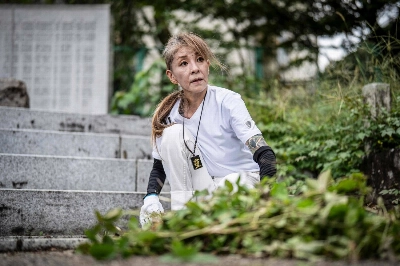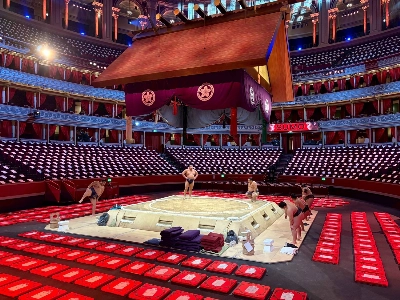In March 1999, when P-3C Orion aircraft from the Maritime Self-Defense Force dropped warning bombs near two suspicious trawlers in the Sea of Japan, it was the first time weapons had been used "in anger" by any SDF unit. The action followed the MSDF receiving its first-ever Cabinet order permitting it to use force if necessary in what was to prove a vain attempt to apprehend the unknown intruders -- this at a time of heightened tension after North Korea test-fired a ballistic missile that overflew Japan the previous August.
But this was to be overshadowed by a similar occurrence within Japan's 200-mile (320-km) exclusive economic zone in the South China Sea in December 2001. Another P-3C sighting set off a chain of events that culminated in a suspect vessel initiating a firefight with pursuing Japan Coast Guard vessels and sinking with the loss of all hands.
Way back in September 1976, the Air Self-Defense Force experienced some embarrassment when a defecting Soviet pilot managed to elude Japanese radar and land what was then the latest MiG-25 interceptor undetected and unimpeded at Hakodate Airport in Hokkaido.
Each one of these episodes has had some bearing on the profile and armament of today's Self-Defense Forces, which some critics malign as an anachronistic throwback to the Cold War era.
To counter the threat from maritime incursions, emphasis has recently been placed on improving communications and cooperation, and the introduction of small, fast, guided-missile patrol boats.
The Hakodate incident was a catalyst for the acquisition of airborne early-warning aircraft to widen radar coverage, and for constant improvement of the SDF's 28 principal radar installations, first installed in 1968. No expense was spared, either, in obtaining a license to build an interceptor to rival the USAF's mighty F-15 Eagle. Even today, each of five ASDF fighter bases keep pairs of armed fighter jets on 24-hour alert. Although there are now only 160 or so "scrambles" a year, compared with a Soviet-era peak of 944 in 1984, Russian aircraft still account for around 75 percent of Japan's airspace incursions.
The ASDF's five bases operate nine interceptor squadrons, seven equipped with the F-15J Eagle. Since its first planes entered service over 20 years ago, aircraft at four of the squadrons have undergone performance-enhancing upgrades, with more scheduled as funds become available.
To increase the F-15's radius of action, Japanese aviators received their first training on in-flight refueling from the USAF last year, and are waiting to receive the first of an expected four Boeing KC-767 refueling tankers in 2006. The caveat that these would be convertible into transports for peacekeeping and humanitarian missions has helped muffle dissenting voices claiming such a capability could be construed as offensive, in direct contravention of Japan's pacifist Constitution. But the fact remains that tankers could play a critical role in any plans to develop a pre-emptive strike capability.
The euphemism "self-defense" has long been seen by some as a thinly veiled attempt to obscure what some of the equipment in Japanese service is truly capable of. But there are signs the term will eventually be dropped, as moves are afoot in the legislature to amend war-renouncing Article 9 of the Constitution to reflect a new, post-Soviet world order and the place the Japanese government wishes to take within it.
The 45,500-strong ASDF currently has a total of 375 combat aircraft, the latest being Mitsubishi's F-2 ground-attack (aka "support fighter") jet, based on the USAF's F-16 Fighting Falcon.
The venerable F-4EJ Phantom, which was also license-built and represented the best 1970s technology had to offer, still fulfills three missions: the air defense of southern Japan and Okinawa; ground attack from Misawa in Aomori Prefecture; and tactical photographic reconnaissance from Hyakuri in Ibaraki Prefecture. Because of political sensitivities, both of these aircraft lack in-flight refueling equipment, so their effectiveness is severely limited -- the combat radius for a typical F-2 mission is only around 800 km, which is roughly the distance from Kyushu to Pyongyang, or Hokkaido to Vladivostok.
Japan's inventory is expected to show a slight drop over the next two years as F-2 deliveries are outpaced by the retirement of its predecessors, the Mitsubishi F-1, and its combat-capable two-seat stablemate, the T-2. Looking to the future, a decision will soon have to be made on a replacement for both the F-4EJs, all of which underwent avionics modernization between 1989 and 1993, and the standard F-15Js, which can only be expected to soldier on for another 10 years. An air-superiority version of the F-2 could be one option.
All ASDF combat aircraft are armed with 20mm cannon and are to a certain extent multi-role fighters. For dedicated ground attack though, their armament can include various permutations of 70mm and 127mm rockets, carried in 19-round, and 4- and 7-round launchers, respectively; guided or unguided 500 lb and 750 lb bombs; and cluster bombs. For the antishipping role, the F-2 can carry up to four missiles, the F-1 and F-4EJ just two. All are capable of firing air-to-air missiles, of which the F-15J can carry a maximum of eight.
The generic MSDF term for the vessels of its potent surface fleet is "escorts," which in other navies would translate as destroyers. Equipped with the latest weapons systems, most also carry a single SH-60J "patrol" helicopter (a Mitsubishi-built naval version of the U.S. Army's Black Hawk), primarily to act as a picket for both submarine and surface target-acquisition purposes. However, the MSDF would like to have the majority, if not all, of its current requirement for 36 of the larger, improved SH-60K version in operation by 2008. In addition to the SH-60J's twin torpedoes, the SH-60K will be armed with Hellfire antiship missiles and depth charges, with pin-mounted machine guns by its side doors.
The pride of the fleet is currently the potent Kongo-class of guided-missile destroyers, the first of which was commissioned in 1993. All four are equipped with the Aegis fleet radar defense system, of which Japan was the first non-U.S. recipient.
After much persuasion from the United States and intense political debate, these started to be dispatched on a rotational basis to the Indian Ocean in November 2001 as part of Japan's contribution to the "war on terrorism" and, importantly, will provide the launching platforms for a new ship-based ballistic missile defense shield to be tested with U.S. support in the latter half of next year.
Weaponry ranges from 74 standard surface-to-air missiles and 16 ASROC antisubmarine rockets to a more conventional, Italian-designed gun, albeit one capable of firing 45 rounds per minute at a distance of 8.7 nautical miles against a surface target, or 3.8 nautical miles against aircraft.
Back in 1988, Japan announced that its forces would never again possess aircraft carriers. Then, last year, the Defense Agency stirred controversy when it released details of the first of two new 13,500-ton DDH (helicopter-carrying destroyer) flagships it is planning to put into service by 2010. Despite sharing the same designation as four other ships equipped with an aft helicopter deck, conceptual drawings show that these ships are much larger, through-deck carriers. These diplomatically featured only three helicopters. But officials were quick to point out that they would be replacing two 1970s vessels, carry no fixed-wing aircraft -- and again provide a boost to Japan's potential peacekeeping and humanitarian capabilities.
For its primary role of protecting Japan's sea lanes beneath the waves, the MSDF maintains a fleet of 18 diesel-powered attack submarines, with the latest class -- the Oyashio -- being armed with 20 torpedoes and/or Harpoon antiship missiles.
Air power accounts for around 12,000 of the MSDF's 45,800 personnel. The MSDF's nine squadrons of four-engined P-3C Orion patrol aircraft operate from five bases, their underwing ordnance hard points typically laden with Harpoon missiles, 330 lb. bombs, or rocket pods. Internally, they can carry up to eight torpedoes. Deliveries commenced in 1981 and were concluded by prime contractor Kawasaki Heavy Industries in 1997. However, a project to build a successor aircraft is already under way (see accompanying feature on defense industry).
The GSDF, which is to be rationalized to 167,000 personnel, possesses some potent hardware as well. Its main battle tanks, the Type 74 and Type
90, have 105mm and 120mm guns, respectively; while other tracked vehicles include the Type 89 armored fighting vehicle, two types of armored personnel carrier and a range of self-propelled guns up to 203mm -- this being capable of firing shells nearly 32 km. Its surface-to-surface missile inventory includes the truck-mounted SSM-1 with its six-tube launcher, as well as multiple-launch rocket systems.
The GSDF's aerial firepower is mainly provided by two-seat AH-1S Cobra helicopters. Kawasaki Heavy Industries delivered 90 of these to five squadrons between 1979 and 2000. These carry the standard armament associated with the Cobra: a triple-barreled 20mm Gatling gun, eight antitank missiles and two launchers carrying 38 70-cm rockets.
Meanwhile, hovering over the horizon and due for delivery next year, prior to the commencement of a license-building program with Fuji Heavy Industries acting as main partner, are the first two U.S.-built examples of the more potent Boeing AH-64D Apache, which totes a 30mm cannon and either 16 Hellfire missiles or a maximum of 76 other rockets.
Production deliveries of the indigenous Kawasaki OH-1 observation helicopter commenced in January 2000. Although it is anticipated that the type will eventually be cleared to carry guns, for now its standard armament is four short-range air-to-air missiles tested last autumn.
When ostensibly unarmed types of helicopters such as the CH-47 Chinook transport are included, the GSDF's helicopter-to-force ratio is around 1:330. This compares favorably with the Chinese army's ratio of 1:4,000.
Both types of utility helicopter in service (the ubiquitous UH-1, which dates back to the Vietnam War, and the UH-60 Black Hawk) are likewise "made in Japan" and can have machine guns fitted to their side doors, with the former also having the ability to carry two side-mounted Type 87 dispensers, each containing 36 antitank mines.
In December 2000, when the Japanese government set in motion its tri-service Mid-Term Defense Build-up Program, the primary aim (in the GSDF's case) was, paradoxically, to streamline the force as a whole and initiate qualitative equipment improvements. A more compact, mobile force composed of nine divisions (reduced from 13), each with 6,000 to 9,000 personnel, four 3,000- to 4,000-strong brigades and a combined brigade -- each operating a mix of helicopters, was envisaged by early 2006.
Controlled from their staff offices in the Defense Agency building in Ichigaya, Tokyo, SDF units are organized into geographic regions, with unit locations largely dictated by bases whose histories often predate World War II. Even so long after the end of the Cold War, the top-heaviness of the GSDF units, in particular those remaining in Hokkaido, are noticeable, if not altogether avoidable.
Meanwhile, the eyes of the nation are fixed on Iraq and the SDF's first dispatch to a zone where attacks by rebel groups are a common occurrence -- the hope being that this will not provide the setting for a tragically defining moment in its 50-year history.
But there will be a price to pay. This year's total defense budget fell by 1 percent from the year before -- to some 4.876 trillion yen, or 0.974 percent of GNP/GDP -- but with Japan seeking to build two new "helicopter carriers" and have the two-tier land- and sea-based missile defense system ready by 2011, it seems likely that the GSDF will bear the brunt of any cutbacks. This will involve it in some stern battles at home as it strives to maintain funding levels to meet its current commitments and still leave scope for future additions -- wherever those may be.
Japan's formidable front-line army
Air Self-Defense Force
Jet fighters (375):
F-1 (18) to be retired by mid-2006;
F-2 (59) includes combat-capable F-2B two-seat trainers (deliveries continuing);
F-4EJ Phantom II (90) all modernized 1989-93, due to be retired by 2014. Figure excludes 12 stored aircraft and 27 RF-4EJ tactical reconnaissance aircraft;
F-15J Eagle (202) includes combat-capable F-15DJ two-seat trainers;
T-2 (6) combat-capable two-seat trainers, due for final retirement in 2005.
Ground Self-Defense Force
Helicopters (282):
AH-1S Cobra (86) anti-tank aircraft license-built 1979-2000;
OH-1 (18) observation helicopters, deliveries continue;
UH-1H/J (155) utility helicopters, UH-1J still in production;
UH-60J/JA (23), license-built version of U.S. Army's Black Hawk, requirement could reach 70.
Tanks (976):
Type 90 (277), in production since 1990;
Type 74 (699), introduced 1974, retirement began 1999.
Maritime Self-Defense Force
Anti-submarine aircraft (195):
P-3C Orion (97), delivered 1981-97;
SH-60J helicopters (96), naval version of Black Hawk, first delivered in 1987;
SH-60K helicopters (2), undergoing evaluation, deliveries of an initial requirement for 38 due to begin 2005.
Warships (54):
Destroyer DD (31), oldest are 11 Hatsuyuki-class (commissioned 1982-87), construction of latest Takanami-class ongoing; Destroyer, Helicopter DDH (4), two Haruna-class (1973-74), two Shirane-class (1980-81); Guided Missile Destroyer DDG (9), includes four Kongo-class "Aegis" vessels;
Destroyer Escorts DE (10), entered service 1981-93.
Attack Submarines (18):
Oldest, Yushio-class, commissioned 1985, six Harushio-class (1990-95), first Oyashio-class commissioned in 1998, two more being built.



















With your current subscription plan you can comment on stories. However, before writing your first comment, please create a display name in the Profile section of your subscriber account page.